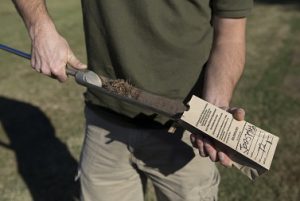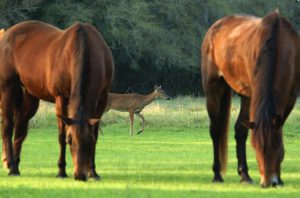
We are ditching the cooler weather of winter and jumping in to the beginning of our warm-season. Spring is the time to be focusing on prepping your pastures for optimal grass production. Hopefully in the past year you have utilized the best soil health indicator we can offer you, a soil test. If not, there is never a bad time to do this.. Soil testing will put you on the fast track to satisfying the nutrient demands of your grass for highest yields and quality.
Use this link for a soil test submission form: edis.ifas.ufl.edu/pdffiles/SS/SS59700.pdf.
Fertilization
Applying fertilizer blind, without a soil test, is not a good management strategy for the environment or for your wallet. Consider applying your fertilizer in more than one application. The reason is simple: the grass in our beloved Florida soils can only make use of a certain amount of nutrients at a given time before the remaining nutrients (primarily Nitrogen) are leached from the soil. Applying fertilizer in smaller quantities ensures you are putting your money directly into that plant and not down the drain. A second application is beneficial later in the growing season to encourage your grass to continue production.
Grazing Management
Remember, the cheapest source of feed you will ever have is that which you can grow in your own pastures. This can be achieved by maintaining soil nutrients and keeping a close eye on the utilization of that pasture grass. Stocking rates and grazing management are imperative. Grass makes more grass, unless you overgraze in which case grass can no longer replenish itself. Discover ways to not limit your pastures this spring and summer and promote grazing into the fall season. These ways might be to invest more time on animal management to control grazing, or cross-fencing pastures to easily employ a rotational grazing system. In the case of horses, developing a sacrifice area can be most beneficial to overall pasture health. The more conservative you manage your grass, the longer you will have production of forage into the fall and the less supplemental forage you will need to purchase.
Nutritional Demands
Consider the types of animals you are feeding. Think critically about their nutritional demands. Can you match those demands with the grass you are producing? Are you overfeeding those animals by providing them with excess concentrate grains and forages? If you are adequately stocked and have horses that are at maintenance (or light work), or cattle in early-mid gestation or open cattle,the answer quite possibly is yes! This is great news, not only can you spend less time and money on additional feed such as concentrate or imported forages, but you will find that managing animals on pasture provides an ease in management, for horses specifically.

Personally, I have peace of mind in knowing my horses are well maintained on pasture and a mineral supplement and not depending on my hectic schedule to feed them in the unnatural twice per day regiment we have become accustomed to. In addition to this, horses are anatomically designed to graze all day, so my pasture system is satisfying the way in which their digestive system operates best.
Hopefully this sparked your interest in investing in your pastures this spring and you employ some of these tips. There are many options available depending on your personal production goals. Please reach out to your local County Extension Agent to discuss your options related to warm-season pastures.
Interested in diving into pasture management? Register for the 2019 Pasture School in Citra, FL by visiting https://www.eventbrite.com/e/cflag-2019-pasture-school-tickets-58000475985
 0
0
